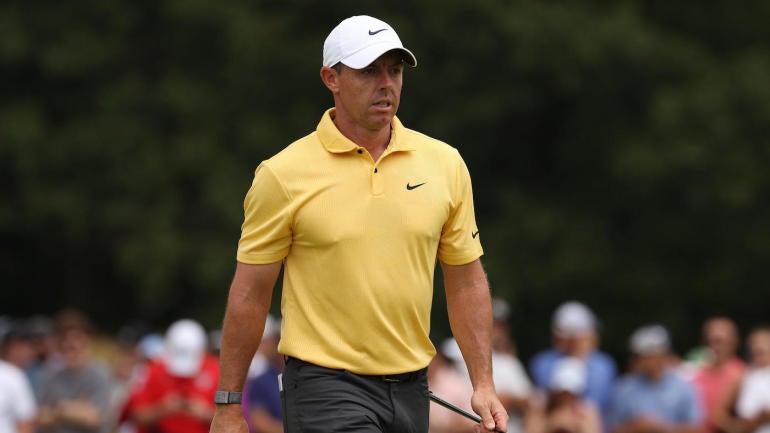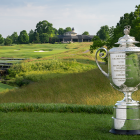
Keegan Bradley fell just shy of the PGA Tour's 72-hole scoring record on Sunday at the Travelers Championship, but he did manage to break the Travelers scoring record for both 54 and 72 holes. It tied the seventh-best 72-hole score in PGA Tour history.
Bradley shot a 23-under 257, and for much of Sunday was within striking distance of Justin Thomas' 72-hole scoring record of 253, which he set at the Sony Open back in 2017.
All of this happened because TPC River Highlands received a ton of rain, which made the golf course a soft, gentle dartboard for much of the week. There were multiple rounds of 60, and the scoring average dropped like a lead weight. If you shot 15 under, you did not crack the top 10. Only one player was over par for the entire week.
"I don't particularly like when a tournament is like this," said Rory McIlroy, who shot 18 under and finished T7 for the week. "Unfortunately technology has passed this course by, right? It sort of has made it obsolete, especially as soft as it has been with a little bit of rain that we had.
"So, again, like the conversations going back to, you know, limiting the golf ball and stuff like that, when we come to courses like this they just don't present the challenge that they used to."
Earlier this year, the USGA and R&A proposed a local model rule that would potentially go into effect in 2026, which would limit how far the golf ball travels. In layman's terms: they would roll the ball back. This would preserve the integrity of longstanding PGA Tour stops and perhaps bring more strategy and options into play at major championships.
There was a big debate during the U.S. Open two weeks ago at Los Angeles Country Club about whether the golf course was too easy as well. The U.S. Open single-round scoring record (62) was set (twice), and fans bemoaned the U.S. Open of yesteryear where knee-high grass made players pull their hair out.
Though McIlroy said that method may be the answer for making TPC River Highlands more difficult, it's not really broadly desirable as a style of play.
"You can grow the rough up and hope you get some firm conditions so it gets tricky," he said about the Travelers. "I think the blueprint for a really good golf course isn't growing the rough up and making the fairways tight. That bunches everyone together.
"The blueprint is something like LACC where you have wide targets, but if you miss it's penal. This isn't that sort of golf course. It's not that sort of layout. It doesn't have the land to do that. You know, unfortunately when you get soft conditions like this and you've got the best players in the world, this is what's going to happen."
McIlroy is mostly discussing TPC River Highlands, but the LACC detour is worth revisiting considering how much consternation there was regarding the U.S. Open layout and given that one of the best players in the world believes that to be "a really good golf course."
When he talks about wide targets and penal misses, he's referencing something that was highlighted over at Data Golf last week after the third major of the year. LACC did provide wide fairways that players hit at a rate consistent with the PGA Tour average (which many fans apparently believe is too often for a major), but the upshot here is that there is more value placed on actually hitting fairways than there is at golf courses where fairways are impossible to hit.

The scoring problem at LACC has little to do with its wide fairways and more so with the fact that technology has erased one of the primary defenses of most golf courses and forced the USGA to lean more heavily on fishing-line-thin decisions to take the firmness of the course to the edge of reasonableness. Though LACC and TPC River Highlands could not be more different in terms of architecture, the reality that technology has rendered them both a bit neutered is disheartening.
On the 540 yard par 4 16th, Rory hit sand wedge and Scottie hit pitching wedge.
— Andy Johnson 🍳 (@AndyTFE) June 16, 2023
I think when we discuss low scores in the professional game, that should probably be where we start.
This is all getting pretty deep in the weeds, but in a year in which technology has been discussed with a vociferousness normally reserved for balancing the federal budget or appeasing tension within the United Nations, it is not unfair to ask whether tech in golf is lapping golf courses the Tour has been going to for several decades and the major championship organizations will want to go to in the future.
Consider these two facts:
- Augusta National spent millions lengthening its famed par-5 13th hole in an attempt to maintain how the hole was intended to be played when it was created nearly 100 years ago.
- Of the 24 lowest 72-hole scores in PGA Tour history, 14 of them have happened since 2013.
If you can read those two sentences and still believe that technology is not a broad threat to men's professional golf, then we must have different views of what we want men's professional golf to be.
During the U.S. Open, my friend Kevin Van Valkenburg of No Laying Up posted a really insightful thread about how desiring a difficult U.S. Open and being anti-rollback are incongruent stances.
Seeing all the frustration last night about how “easy” this US Open has been thus far crystallized something this morning: You cannot sincerely hold that position and *also* be against any kind of rollback of the ball/equipment. The two cannot coexist.
— Kevin Van Valkenburg (@KVanValkenburg) June 16, 2023
It should be noted here that rollback would likely -- though not necessarily always -- benefit the best flushers of the ball such as McIlroy, who has more explicitly advocated for the USGA and R&A proposal. What he's supporting is probably good for the game, sure, but it is also good for himself. A short (non-exhaustive) point that makes this land: Do you think Rory wants courses constructed to require more sand and gap wedges or more 4 irons and 3 irons?
Regardless, as scores get lower and lower even as courses get longer and longer, we are reaching an inflection point in the game. The USGA and R&A know this, which is why the proposed the model local rule for 2026.
There are three options here, and probably only three.
- Throw all of this to the wind, don't worry about scoring at all and, more importantly, don't worry about how golf courses were meant to be played.
- Start going to different, longer courses that have not been passed by.
- Implement restrictions on equipment.
One of those is clearly most appealing to golf fans, and thankfully it lines up from an incentives standpoint with the one that is most appealing to the best players in the world as well.





















